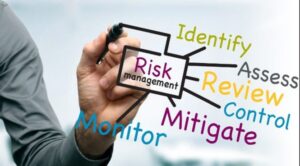In the dynamic landscape of business, where opportunities and challenges intertwine, the wise entrepreneur understands the crucial importance of business risk management. The path to success is not without its perils, but with careful planning and strategic foresight, these business risks can be mitigated effectively. Welcome to the realm of “Mitigating Business Risks: A Comprehensive Guide to Selecting and Optimizing Business Insurance Coverage,” where we embark on a journey of safeguarding businesses against the unexpected.

In this ever-evolving business landscape, business risks can arise from various sources – from natural disasters and property damage to legal liabilities and cyber threats. The key to navigating these treacherous waters lies in understanding the role of comprehensive insurance coverage. A robust insurance strategy not only shields businesses from potential financial losses but also provides peace of mind, enabling entrepreneurs to focus on growth and innovation.
Assessing Business Risks
Assessing business risks is a crucial aspect of proactive risk management that enables organizations to identify and understand potential threats to their operations, financial stability, and reputation. By conducting a comprehensive assessment, businesses can gain valuable insights into the nature and impact of risks, allowing them to develop effective strategies for mitigating and managing these business risks.
SEE ALSO: HOMEOWNERS INSURANCE POLICY AND BEST TO BENEFIT FROM IT
The process of assessing business risks begins with a thorough understanding of the different types of risks that businesses may face. These business risks can be categorized into various areas such as operational, financial, legal and regulatory, reputational, and strategic risks. Each category encompasses specific business risks that require careful consideration and evaluation.
To identify potential business risks, businesses must engage in a systematic evaluation of their internal operations, external environment, and industry trends. This can involve analyzing processes, systems, and vulnerabilities within the organization, as well as considering external factors such as market conditions, competition, and regulatory changes. By involving key stakeholders, such as employees, managers, and industry experts, businesses can gain diverse perspectives and insights into potential business risks.
Once potential business risks are identified, it is essential to evaluate their likelihood of occurrence and potential impact on the organization. This assessment involves analyzing historical data, industry trends, expert opinions, and any internal or external factors that may influence the probability and severity of each risk. Assigning numerical values or qualitative assessments to the likelihood and impact of risks helps in prioritizing and focusing resources on the most significant risks.
A comprehensive risk assessment also involves analyzing the interdependencies between different risks. Understanding how risks may interact and influence one another is crucial in developing an effective risk mitigation strategy. Some risks may amplify or trigger other risks, and considering these interconnections allows for a more holistic approach to risk management.
Prioritizing risks based on their potential impact and probability helps businesses allocate resources effectively and develop targeted risk mitigation strategies. By identifying high-priority risks, organizations can focus their attention and resources on implementing appropriate controls and measures to minimize the potential impact of these risks.
Assessing risk controls and mitigation measures already in place within the organization is an important step in the process. This evaluation helps identify any gaps or weaknesses in the existing control environment, allowing businesses to make improvements or implement additional controls as necessary.
Quantifying risks by assigning numerical values to factors such as likelihood, impact, and velocity provides a more objective basis for comparing and prioritizing risks. Quantitative assessment techniques, such as probabilistic modeling or cost-benefit analysis, can support this process, providing a clearer understanding of the magnitude and significance of each risk.
READ ALSO: TYPES OF INSURANCE POLICIES
The outcomes of the risk assessment process should inform the development of risk mitigation strategies. These strategies may include risk avoidance, risk reduction, risk transfer, or risk acceptance, depending on the nature and characteristics of each risk.
Developing action plans that outline specific tasks, responsibilities, and timelines for implementing mitigation measures ensures a systematic and effective approach to risk management.
Regular monitoring and reviewing of risks are critical to ensure the continued effectiveness of risk mitigation strategies. By monitoring key risk indicators, reassessing business risks periodically, and making adjustments as needed, businesses can adapt to changing circumstances and emerging risks.
Understanding Insurance Coverage Types
Understanding Insurance Coverage Types is essential for businesses to protect themselves against potential risks and losses. Insurance serves as a crucial tool in managing uncertainties and providing financial security in the face of unexpected events. By familiarizing themselves with various coverage types, businesses can make informed decisions about the specific insurance policies they need to mitigate risks effectively.

One of the primary coverage types is general liability insurance, which protects businesses from claims related to bodily injury, property damage, and personal injury caused by their operations, products, or services. This coverage provides financial support for legal expenses, settlements, or judgments that may arise from such claims.
Property insurance is another vital coverage type that safeguards businesses against property damage or loss caused by perils like fire, theft, vandalism, or natural disasters. It typically covers the physical structure of the business premises, as well as equipment, inventory, and other assets.
Professional liability insurance, also known as errors and omissions insurance, is crucial for service-based businesses or professionals. It protects against claims of negligence, errors, or omissions in the provision of professional services. This coverage provides financial support for legal defense costs, settlements, or damages awarded to clients or third parties who suffer harm as a result of professional mistakes or inadequate advice.
Commercial auto insurance is essential for businesses that utilize vehicles for their operations. It covers vehicles used for business purposes, providing protection against accidents, property damage, or injuries caused by company-owned vehicles or employees driving on behalf of the business.
Cyber insurance has become increasingly important in the digital age, offering coverage for losses resulting from data breaches, cyberattacks, or other cyber incidents. This coverage assists businesses in managing the costs associated with data recovery, legal expenses, regulatory fines, and reputational damage resulting from cyber incidents.
Workers’ compensation insurance is a statutory coverage that provides wage replacement and medical benefits to employees who suffer work-related injuries or illnesses. It helps businesses fulfill their legal obligations to provide financial support to injured employees and protects against potential lawsuits related to workplace injuries.
Business interruption insurance is designed to assist businesses during periods of suspended operations due to covered events, such as natural disasters, fires, or other unforeseen circumstances. It provides financial support to cover ongoing expenses, lost profits, and additional costs associated with temporary closure or relocation.
Understanding these various insurance coverage types is vital for businesses to assess their specific risk exposures and select policies that adequately address their needs. By partnering with insurance professionals or brokers, businesses can gain further insights and guidance to ensure they secure appropriate coverage tailored to their unique circumstances.
Determining Coverage Needs
Determining Coverage Needs is a crucial step in the process of selecting appropriate insurance policies for businesses. Each organization has unique risk exposures, and understanding the specific coverage requirements is essential to ensure adequate protection against potential losses. By carefully assessing their operations, assets, and potential liabilities, businesses can make informed decisions about the types and levels of coverage they need.
To determine coverage needs, businesses should consider the following factors:
- Nature of Operations: Analyze the nature of your business operations and identify the potential risks associated with them. Consider the specific industry you operate in, the types of products or services you offer, and any inherent risks that come with your operations. This assessment helps in identifying the primary areas where insurance coverage may be necessary.
- Assets and Property: Evaluate your business assets, including buildings, equipment, inventory, and other valuable property. Determine the replacement or repair costs of these assets and consider the potential financial impact if they were damaged, destroyed, or stolen. Property insurance coverage should be aligned with the value of these assets to ensure proper protection.
- Liability Exposures: Assess the potential liability exposures your business may face. Identify the risks of bodily injury or property damage to third parties that could arise from your operations, products, or services. Consider the potential costs of legal defense, settlements, or judgments if a liability claim is filed against your business. General liability or professional liability insurance may be necessary to address these exposures.
- Contractual Requirements: Review any contractual obligations or agreements your business has entered into. Determine if there are specific insurance requirements outlined in these contracts, such as minimum coverage limits or additional insured endorsements. It is crucial to ensure compliance with contractual insurance obligations to protect your business’s interests and maintain good business relationships.
- Regulatory Compliance: Understand the regulatory environment in which your business operates. Determine if there are specific insurance requirements mandated by regulatory bodies or government agencies. Compliance with these requirements is essential to avoid penalties and ensure that your business is adequately protected against potential liabilities.
- Employee Protection: Assess the needs for insurance coverage to protect your employees. Consider workers’ compensation insurance to provide wage replacement and medical benefits in the event of work-related injuries or illnesses. Additionally, evaluate the need for employee benefits such as health insurance, disability insurance, or life insurance, which can enhance employee well-being and retention.
- Risk Appetite: Consider your organization’s risk appetite and tolerance. Evaluate the financial capacity of your business to absorb potential losses and determine the level of risk you are comfortable assuming. Balance the desire for cost-effective coverage with the need for adequate protection against potential business risks.
- Future Growth and Expansion: Anticipate future growth or changes in your business that may impact your coverage needs. Evaluate how your insurance coverage can adapt to accommodate business expansions, acquisitions, new product lines, or geographical expansions. Ensure that your coverage can scale with your business’s changing needs.
By carefully evaluating these factors, businesses can determine their coverage needs and make informed decisions when selecting insurance policies. It is advisable to consult with insurance professionals or brokers who can provide expert guidance and help customize coverage options based on the specific risks and requirements of your business.
Conclusion
In conclusion, mitigating business risks through a comprehensive guide to selecting and optimizing business insurance coverage is a vital endeavor for organizations seeking to protect their interests, assets, and reputation.
GERMANY DAAD SCHOLARSHIPS WITHOUT IELTS, APPLY NOW!
By understanding the various types of risks they may face, businesses can make informed decisions when selecting insurance coverage tailored to their specific needs. The process begins with a thorough assessment of potential risks, followed by an evaluation of the appropriate coverage types required for adequate protection.
